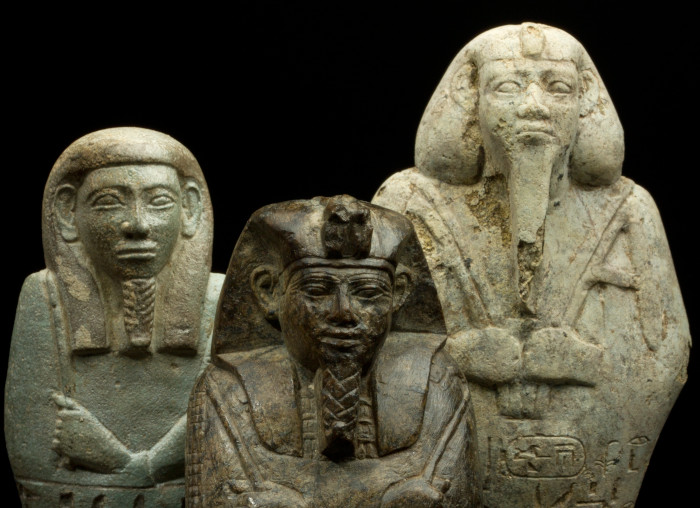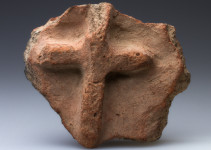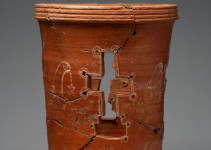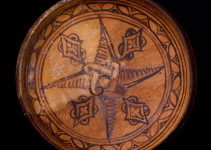Exhibitions
Departments
The three kingdoms
Three separate states arose in the 6th century AD in the territory of today’s northern Sudan. In Lower Nubia, it was the kingdom of Nobatia with its capital in Faras, bordering with Makuria (modern Dongola Reach) in the south, while on the Blue Nile grew the kingdom of Alwa (Alodia) with the city of Soba as its centre. Already in the 5th century, the first monks spreading the knowledge of Christianity began to reach this area from Egypt. Political foresight led the rulers of the Nubian kingdoms, who closely followed the situation in Byzantine Egypt and Christianized Ethiopia, to adopt the new religion of the Empire – Christianity. At the same time, Christianity in the East was experiencing a doctrinal schism. The proponends of Dyophysitism who were favoured by the Emperor Justinian, recognised that Christ had both a divine and a human nature, while the proponents of Monophisitism accepted only one indivisible divine nature.
Under the sign of the Cross
About 543 AD the ruler of Nobatia was babtised by priest Julian, adopting Christianity according to the Monophysite doctrine. This fact coincided with closure of the last Egyptian temple on the island of Philae by the emperor Justinian, and so both dates mark the symbolic end of antiquity on the Nile. The Christianization of Nubia was continued by Longinus, who in 580 converted the inhabitants of the kingdom of Alwa. Several years earlier the Christian religion had been adopted by Makuria, then in open military conflict with its neighbours. In the beginning of the 8th century, the kingdom of Makuria managed to incorporate Nobatia and thus established a large state which was to go through a period of political and cultural prosperity over the next centuries.
In view of the preserved monuments of Nubian literature, as well as the accounts of Arab travellers at the time, it seems that the secular power in medieval Nubia was to remain basically separate from the church, although the ruler could perform official religious functions, including the celebration of the liturgy. The court ceremonial and royal insignia as well as the titles of the highest officials derived from the Byzantine tradition. The Nubian church was nominally subordinate to the Coptic patriarchs of Alexandria, who personally appointed the Metropolitan and Bishops of Makuria and Alwa.
The complex of 120 wall paintings uncovered in the Faras Cathedral (7th-9th century AD) and the variety of architectural forms of Old Dongola's churches as well as the numerous Greek and Coptic written records found there, best testify to the level of artistic activity and intellectual life concentrated in numerous monasteries and religious centres.
Kings and saints from Locust Island
One of the most interesting discoveries of recent years was made by Polish archaeologists at Banganarti (Locus Island in the local dialect). Thanks to the photographs of the area taken from the air, it was possible to locate the remains of a huge complex surrounded by a ring of walls and towers. The central part of the complex is a magnificent basilica, built on a cross-plan and originally covered with a dome. On the eastern side, a row of chapels with apses are adjacent to the church. The walls of each of these chapels are decorated with paintings of exceptional quality, often forming several layers, laid one upon another consecutively over the centuries. They repeat a similar composition scheme: one of the archangels protects a Nubian ruler dressed in ceremonial robes and accompanied by twelve apostles.
It is possible that in the Middle Ages the church could also have served as a royal mausoleum - a burial place for members of the dynasty ruling in nearby Dongola. In its heyday, Banganarti must have been one of the most important religious centres of Nubia, visited by crowds of pilgrims leaving hundreds of inscriptions and graffiti on the walls of the building.
Islam
The Arabs, who conquered Egypt in the 7th century, made two unsuccessful attempts to invade Nubia. The peace treaty (in Arabic sources: baqt) that was concluded in 652 guaranteed Nubian independence and freedom in exchange for an annual tribute of slaves and a promise to erect a mosque at Dongola. Over the next centuries Makuria had regular diplomatic relations with the Arab world. The situation changed only in the 12th century. This was a time of unrest in Nubia, evidenced by the construction of numerous forts. The northern kingdom of Makuria practically collapsed in 1323 and was taken over by a new Arab dynasty of the Beni Kanz tribe. In the south, Alwa survived for nearly two hundred years, constantly attacked by Arab Bedouin and finally conquered by a Muslim ruler of the Funj people. Since then, the green flag of Islam has fluttered over Sudan.
Nasza strona internetowa używa plików cookies (tzw. ciasteczka) w celach statystycznych, reklamowych oraz funkcjonalnych. Dzięki nim możemy indywidualnie dostosować stronę do twoich potrzeb. Każdy może zaakceptować pliki cookies albo ma możliwość wyłączenia ich w przeglądarce, dzięki czemu nie będą zbierane żadne informacje. Dowiedz się więcej jak je wyłączyć. OK, Rozumiem






